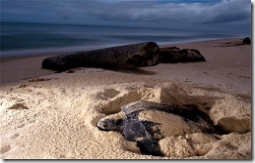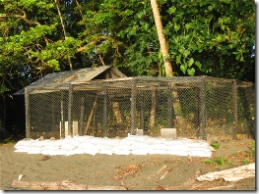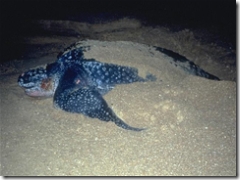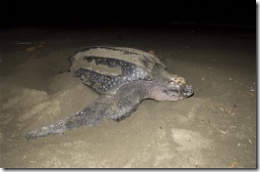A Long Patrol of Turtle Love
April 20, 2007
 We arrived into Costa Rica on a Wednesday afternoon and spent our first night at Gaudy’s Backpackers in the capital, San Jose. The next day we headed out to ANAI headquarters and got briefed by Claudio, the director I think, on what is expected from us as volunteers working with Leatherback Sea Turtles. Once finished we caught a bus to the Caribbean coast and met the rest of the crew. We were taught how to work with the turtles and found out 3 groups of 2 or more people are sent out every night to patrol the beach looking for nesting turtles. The first group goes from 8-12, the next 10-2, and the last 12-4. Here are our accounts from our nights on patrol.
We arrived into Costa Rica on a Wednesday afternoon and spent our first night at Gaudy’s Backpackers in the capital, San Jose. The next day we headed out to ANAI headquarters and got briefed by Claudio, the director I think, on what is expected from us as volunteers working with Leatherback Sea Turtles. Once finished we caught a bus to the Caribbean coast and met the rest of the crew. We were taught how to work with the turtles and found out 3 groups of 2 or more people are sent out every night to patrol the beach looking for nesting turtles. The first group goes from 8-12, the next 10-2, and the last 12-4. Here are our accounts from our nights on patrol. 
The first night: We eat dinner with the team at six; everyone goes to sleep shortly after. The alarm goes off at 9:50; we dress and wait for Andrey, the leader, and two others to head out on our first patrol. Andrey is fairly quiet so little is said a s we walk along the 8 mile roundtrip in the sand. The moon hangs low and out of sight behind the thick, tropical forest lining the sandy beach where fireflies sketch patterns on the black canvas night. Lights from Puerto Viejo lie in the distance and grow brighter as we walk on, plankton wash ashore beneath our feet with a shimmer of light, numerous stars dot the sky with an occasional shooting star catching our gaze. We approach the end of the beach and see lights; lights not ours or of another patrol team. “Poachers” Andrey says. Posing as fisherman there is nothing we can do, especially without a Park Ranger. The poachers are not dangerous and don’t want to harm anyone. They just want the eggs and usually get them. We turn and head back for bed. The clock reads 2:04. No turtles. Night two goes much the same.
 Night three: Starting much the same as previous nights we walk along in the silence of the night. Our group only consists of three; Andrey, Rachel, and myself. Coming close to the halfway point Rach and I begin to get our hopes up and wonder if we will at least glimpse one of these illusive and solitaire creatures of the sea. Then there she is. Tractor size tracks lead back to the sea, her nest already laid, and she is camouflaging the area to confuse predators. Andrey marks where he thinks the nest is with a stick. He gets anxious with the feeling that another leatherback is close and wants to move to the end of the beach. I am handed a can of pepper spray. Andrey says in broken English, “Here the trigger” and “you stay with turtle.” Rachel and Andrey disappear. I stand there with protection in hand overlooking a giant turtle making infrequent grunting noises. An ominous figure catch
Night three: Starting much the same as previous nights we walk along in the silence of the night. Our group only consists of three; Andrey, Rachel, and myself. Coming close to the halfway point Rach and I begin to get our hopes up and wonder if we will at least glimpse one of these illusive and solitaire creatures of the sea. Then there she is. Tractor size tracks lead back to the sea, her nest already laid, and she is camouflaging the area to confuse predators. Andrey marks where he thinks the nest is with a stick. He gets anxious with the feeling that another leatherback is close and wants to move to the end of the beach. I am handed a can of pepper spray. Andrey says in broken English, “Here the trigger” and “you stay with turtle.” Rachel and Andrey disappear. I stand there with protection in hand overlooking a giant turtle making infrequent grunting noises. An ominous figure catch es the corner of my eye and slides out of the sea. Another turtle. She makes her way above the high tide line as the other finishes the job and disappears into the waves. I wonder where my team has gone. Half an hour has passed; they were supposed to back in half that time. I try signaling with my flashlight, but to no avail. I assume they found another turtle. This is confirmed 15 minutes later as they appear with a bag of eggs in hand. I point out the new turtle. Andrey panics again and quickly digs a nest to relocate the eggs he has. Then his attention turns to the turtle which is nearly done digging her nest. We watch her curl up her back fins to scoop out the dirt to make a deep nest. It is quite amazing to see. She finishes and prepares to lay her eggs. Andrey puts me down on my stomach with my head at the back of turtle with a bag inside the nest to catch the eggs. I hold it as close to her as I can and she begins. I can feel her breath and the eggs as they drop in 3’s. While doing this Rachel and Andrey check for a PID identification tag, flipper tags, take measurements, a tissue sample, and write down other information like shark bites on the shell or rips in her flippers. She then lowers one flipper into the nest to make sure the eggs are there. Andrey yells “Take! Take!” at me and I quickly pull the bag out before she could fill it with sand. We cover the eggs with sand to keep warm as we begin searching for the nest of the first turtle. A while later the other patrol group catches up to us. Together we dig for the eggs, but we are unable to find them. They take the sack of eggs and relocate them further down shore and we head back to base. On the way back another turtle comes up and decides to trick us by pulling the old ‘false crawl’ and heads back into the ocean without nesting. We are all tired and thankful for this and get to bed a little past 5:00 in the morning. Witnessing the sheer enormity and strength of these animals was amazing. It was a long, but very exciting and unforgettable night for us all.
es the corner of my eye and slides out of the sea. Another turtle. She makes her way above the high tide line as the other finishes the job and disappears into the waves. I wonder where my team has gone. Half an hour has passed; they were supposed to back in half that time. I try signaling with my flashlight, but to no avail. I assume they found another turtle. This is confirmed 15 minutes later as they appear with a bag of eggs in hand. I point out the new turtle. Andrey panics again and quickly digs a nest to relocate the eggs he has. Then his attention turns to the turtle which is nearly done digging her nest. We watch her curl up her back fins to scoop out the dirt to make a deep nest. It is quite amazing to see. She finishes and prepares to lay her eggs. Andrey puts me down on my stomach with my head at the back of turtle with a bag inside the nest to catch the eggs. I hold it as close to her as I can and she begins. I can feel her breath and the eggs as they drop in 3’s. While doing this Rachel and Andrey check for a PID identification tag, flipper tags, take measurements, a tissue sample, and write down other information like shark bites on the shell or rips in her flippers. She then lowers one flipper into the nest to make sure the eggs are there. Andrey yells “Take! Take!” at me and I quickly pull the bag out before she could fill it with sand. We cover the eggs with sand to keep warm as we begin searching for the nest of the first turtle. A while later the other patrol group catches up to us. Together we dig for the eggs, but we are unable to find them. They take the sack of eggs and relocate them further down shore and we head back to base. On the way back another turtle comes up and decides to trick us by pulling the old ‘false crawl’ and heads back into the ocean without nesting. We are all tired and thankful for this and get to bed a little past 5:00 in the morning. Witnessing the sheer enormity and strength of these animals was amazing. It was a long, but very exciting and unforgettable night for us all. 
 Night four: Rachel and I are put on hatchery watch from 12-6 to make sure no poachers come in and steal any of the eggs we’ve managed to save. Besides from me falling asleep several times and our imaginations getting the better of us, our shift was uneventful.
Night four: Rachel and I are put on hatchery watch from 12-6 to make sure no poachers come in and steal any of the eggs we’ve managed to save. Besides from me falling asleep several times and our imaginations getting the better of us, our shift was uneventful.
The last night of patrol: We were lucky and managed to swing the early shift from 8-12. At the end of the beach we encounter poachers again who were “fishing” as usual. They do little to acknowledge our presence. A very odd feeling when you’re both alone on the beach in the middle of the night, not to mention discouraging knowing they’ll take the eggs of a turtle if it comes to shore. The night rolls on seemingly slower than before. I look forward to our final rest stop at marker 44 which signifies one hour to go before reaching base. We approach our normal log to sit down, but reach a turtle first. She is very small and battered with many chunks missing from her back flippers. This makes it increasingly difficult to dig more than a shallow nest for her eggs. She does the best she can though and gives us time to get into position. Rachel is on her stomach waiting for the eggs to drop in. I have clipboard in hand and follow Patricio, our team leader for the night, around as we take measurements and notes. He finds she doesn’t have a PID and shows me how they insert it into their upper right flipper using a 3 inch needle as the turtle takes a breath. She starts bleeding everywhere. “Most of the time they don’t bleed, but a few times it goes everywhere” Patricio says while cleaning the wound. Next he puts one tag on each rear flipper and a takes a tissue sample. She starts bleeding from that too and it begins to drip on Rachel’s arm. The turtle seems not to notice any of this or care and is solely focused on laying her eggs. She finishes lying and they pull the bag out of the hole. I receive a blast of sand in my face as she covers everything up and I deci de to move. Patricio relocates the eggs down beach and makes the real nest look like it’s already been poached. Hopefully this will be enough to confuse the poachers. We take a brief rest and head back for the night, talk with the next team coming out, and make it back by 1:00.
de to move. Patricio relocates the eggs down beach and makes the real nest look like it’s already been poached. Hopefully this will be enough to confuse the poachers. We take a brief rest and head back for the night, talk with the next team coming out, and make it back by 1:00.
During the days, when we were not lethargic, we would go play in the waves of the beach, get games of volleyball or soccer going in the sand, travel to either Cahuita or Puerto Viejo to eat something other than rice and beans, and catch up with friends and family on the Internet. We went snorkeling and saw small coral reef formations, and went on hikes inside the Cahuita National Park where we saw heaps of hermit crabs scuttling along the trail next to larger red and blue crabs, caught glimpses of lizards and frogs, perhaps a toucan, poisonous snakes, and of course the curious white faced monkeys. A fun time spent on the beach with great volunteers and experiences.
 We travel: to learn and grow, to challenge ourselves, stretch our limits and foster an appreciation of both the world at large and our own back home.
We travel: to learn and grow, to challenge ourselves, stretch our limits and foster an appreciation of both the world at large and our own back home.
Mariana
29 Dec, 2007
I link your experience in cahuita in our blog, i hope its ok!
please help us to sprees the word about our website and the blog…
thanks for everything
Sue Keene
6 Jun, 2008
Thank you for sharing this. My daughter is presently in Costa Rico working with the same organization and I have been wondering what she is doing. This sounds so exciting and rewarding.